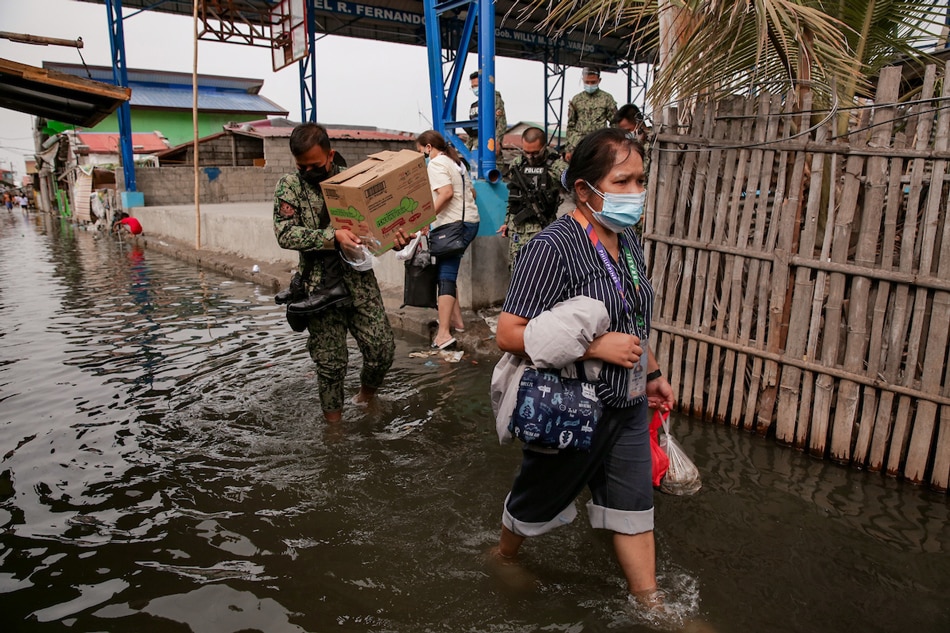Metro Manila, Bulacan among top PH areas at risk of climate damage to built environment: report | ABS-CBN

Welcome, Kapamilya! We use cookies to improve your browsing experience. Continuing to use this site means you agree to our use of cookies. Tell me more!
Metro Manila, Bulacan among top PH areas at risk of climate damage to built environment: report
Metro Manila, Bulacan among top PH areas at risk of climate damage to built environment: report
Rowegie Abanto,
ABS-CBN News
Published Feb 25, 2023 12:54 PM PHT
Pangasinan tops list, Cebu included
Pangasinan tops list, Cebu included
MANILA — Metro Manila and Bulacan are among the top 20 areas in the Philippines at risk of climate damage to the built environment, with Pangasinan topping the list, a new report showed.
MANILA — Metro Manila and Bulacan are among the top 20 areas in the Philippines at risk of climate damage to the built environment, with Pangasinan topping the list, a new report showed.
Over 80 areas in the country landed in the 2023 Gross Domestic Climate Risk ranking of more than 2,600 territories worldwide by the XDI, an independent specialist in physical climate risk and adaptation analytics.
Over 80 areas in the country landed in the 2023 Gross Domestic Climate Risk ranking of more than 2,600 territories worldwide by the XDI, an independent specialist in physical climate risk and adaptation analytics.
According to the XDI, the report was based on its projections of damage to the built environment due to the effects of the climate crisis including flooding, forest fires, and sea level rise.
According to the XDI, the report was based on its projections of damage to the built environment due to the effects of the climate crisis including flooding, forest fires, and sea level rise.
The Philippines, home to 110 million people, with many experiencing poverty, regularly experiences flooding due to rains and storms, averaging 20 per year.
The Philippines, home to 110 million people, with many experiencing poverty, regularly experiences flooding due to rains and storms, averaging 20 per year.
ADVERTISEMENT
Sea levels in the country are also rising 3 times faster than the global average, according to the state weather bureau, citing a joint study with the United Kingdom's Hadley Centre.
Sea levels in the country are also rising 3 times faster than the global average, according to the state weather bureau, citing a joint study with the United Kingdom's Hadley Centre.
Here are the top 20 areas in the Philippines at risk of climate damage, based on the ranking's aggregated damage ratio metric, which measures the annual sum of damage in a state or province.
Here are the top 20 areas in the Philippines at risk of climate damage, based on the ranking's aggregated damage ratio metric, which measures the annual sum of damage in a state or province.
- Pangasinan
- Pampanga
- Nueva Ecija
- Cagayan
- Tarlac
- Metro Manila
- Bulacan
- Isabela
- Davao del Sur
- Leyte
- Ilocos Sur
- Batangas
- Cebu
- Oriental Mindoro
- Quezon
- Laguna
- Zambales
- Negros Occidental
- South Cotabato
- Misamis Oriental
- Pangasinan
- Pampanga
- Nueva Ecija
- Cagayan
- Tarlac
- Metro Manila
- Bulacan
- Isabela
- Davao del Sur
- Leyte
- Ilocos Sur
- Batangas
- Cebu
- Oriental Mindoro
- Quezon
- Laguna
- Zambales
- Negros Occidental
- South Cotabato
- Misamis Oriental
The XDI report found that major centers of global trade, manufacturing, and economic activity were "among the most exposed" to extreme weather and climate change.
The XDI report found that major centers of global trade, manufacturing, and economic activity were "among the most exposed" to extreme weather and climate change.
"Ports, manufacturing centers, and megacities in Asia and large economic powerhouse states in the United States dominate our list of the provinces and territories with the most to lose from accelerating climate change," the XDI said.
"Ports, manufacturing centers, and megacities in Asia and large economic powerhouse states in the United States dominate our list of the provinces and territories with the most to lose from accelerating climate change," the XDI said.
The report notes that a high ranking for the aggregated damage ratio metric reflects that states, provinces, and territories, "where extensive built-up areas, coincide with exposure to climate change and extreme weather hazards."
The report notes that a high ranking for the aggregated damage ratio metric reflects that states, provinces, and territories, "where extensive built-up areas, coincide with exposure to climate change and extreme weather hazards."
ADVERTISEMENT
"Larger territories tend to be higher in this ranking because they have a greater extent of built-up areas," it added.
"Larger territories tend to be higher in this ranking because they have a greater extent of built-up areas," it added.
The XDI's analysis, it said, does not include the social, environmental, and economic effects of the climate crisis such as water shortage and agricultural impact.
The XDI's analysis, it said, does not include the social, environmental, and economic effects of the climate crisis such as water shortage and agricultural impact.
In a study conducted by 2 German institutions last year, the Philippines emerged as the most disaster-prone country in the world.
In a study conducted by 2 German institutions last year, the Philippines emerged as the most disaster-prone country in the world.
RELATED VIDEO:
RELATED VIDEO:
ADVERTISEMENT
ADVERTISEMENT


